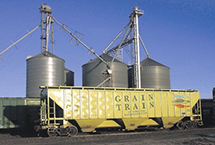 |
 |
|
| eNews • May 2015 | ||
| Promoting a Cost-Effective, Reliable and Competitive Transportation System |
||
 STC analysis concludes with high grades for rail service
STC analysis concludes with high grades for rail service
The Soy Transportation Coalition (STC) and the University of Minnesota have concluded the research project, “2014 Harvest: Attaching a Garden Hose to a Fire Hydrant.” The following are highlights from the tenth and final survey period of March 27 - April 10.
Summary: Rail Service Results (March 27 - April 10):
"Fortunately, the rail service disruptions from 2014 have not been repeated,” explains Mike Steenhoek, executive director of the Soy Transportation Coalition. “Rail service metrics have dramatically improved across the board. Railroads responded to last year’s challenges with an aggressive level of investment. This has clearly paid dividends."
In the most recent update, 94 percent of participating grain handling facilities report that cycle times for railroads are faster than a year ago - an increase from 67 percent in the first survey. Survey respondents reported experiencing 2.49 turns per month between their facilities and the Pacific Northwest - the highest number recorded throughout the ten survey periods.
"We appreciated the opportunity to work with the University of Minnesota on this worthwhile project," says Steenhoek. “Last year farmers expressed a high degree of frustration with current rail service and significant anxiety regarding future service. In 2014, farmers experienced a decline in profitability not because of anything they did or did not do, but rather due to unreliable and inadequate rail service. It was an example of how farmers should not regard transportation as a theoretical. It should be regarded as something that has tangible impact on their bottom line. I am pleased that the farmer board of directors of the Soy Transportation Coalition were willing to quickly respond to this concern by approving the research project with the University of Minnesota. We thought it was important for a farmer-funded, farmer-led organization, like the STC, to assess and provide commentary on rail performance for the 2014 harvest."
As highlighted in prior updates, the overall favorable performance of the railroads in the analyzed area of the country has been attributed to the following:
- An elongated harvest season. Given how the 2014 harvest occurred over a more elongated period of time, railroads were better able to adjust to the volumes produced by farmers. Historically, when the harvest occurs over a more condensed period of time, railroads are more challenged to accommodate demand for service.
- Railroads have responded to demand. In one of the recent survey periods, one of the participants stated, "CP (Canadian Pacific) is turning like we’ve never seen before. Loads are pulled more promptly. BN (BNSF Railway) is about the same; they have improved on pulling loaded trains quicker." Another survey respondent said, "Actually very pleased with both Class I railroads (BNSF Railway and Canadian Pacific Railway)."
- Farmers storing grain. According to one of the survey respondents, “With the drop in grain prices over the past five weeks, farmers are disengaged in marketing any additional bushels.” This has reduced to a degree demand for rail service.
- Favorable weather. While there was some significant snowfall and cold temperatures during the winter of 2014/2015, the weather overall was favorable for transporting soybeans and grain in the surveyed areas.
- More modest harvest volumes than anticipated. While the 2014 harvest will be regarded as significant and perhaps historic, a number of the surveyed areas have reported more modest volumes than earlier anticipated. Survey respondents mentioned “poorer crops” in certain areas and the harvest not “as expected.”
The full results of the bi-weekly survey can be accessed at www.soytransportation.org.
Project Description:
While transportation concerns throughout much of 2014 were evident throughout the country, a particular region - North Dakota, South Dakota, Minnesota, and Nebraska - experienced particular hardship over the past year due to having more limited access to alternative transportation providers and modes. Most of these areas solely rely on freight rail. As a result, the supply/demand transportation imbalance had a more punitive effect on agriculture and individual farmers in these regions than other areas of the country.
Given the acute rail service challenges throughout much of 2014 and given the projected record 2014 harvest, widespread concern regarding rail performance was expressed by grain handlers and farmers in the weeks and months preceding the 2014 harvest.
The research project was designed to monitor and document rail service for the 2014 harvest in areas of North Dakota, South Dakota, Minnesota, and Nebraska. The project identified and estimated the impact of rail service on the profitability of each state’s agricultural industry and individual farmers.
A component of the research was a bi-weekly survey of 42 grain receiving locations in these states. The surveys began in early November and extended through April of 2015. Completed anonymously, the survey was comprised of the following questions:
- If you load shuttle trains, what is the current number of cycles/turns per month?
- Is your cycle time/turns faster or slower than one year ago?
- How many days past due is your oldest open order for railcars?
- How many railcar orders are past due (or passed order date)?
- What percent of your permanent storage capacity remains open?
- If your permanent storage is full, are you creating ground piles or using bunkers, bags and/or other forms of temporary storage?
- Due to a lack of storage, have you closed your truck dumps to farmers?
- If so, how long have your dumps been closed?
- Is there more or less pressure on storage capacity since the last survey?
- Have you experienced rail service delays and diminishing storage capacity?
- If experiencing rail service delays and diminishing storage capacity, estimate the impact on your local basis for each grain handled at your facility.
- What are spot prices on rail freight that you can purchase today?
Soy Transportation Coalition |
|
